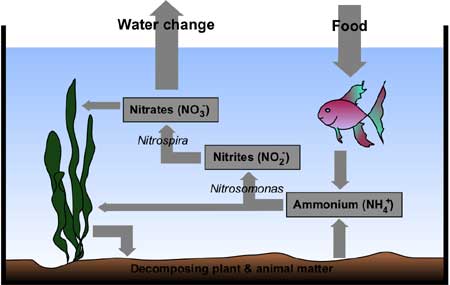When people are talking about their fish, any non-fish hobbyiest can pick up that ammonia is a bad thing. They may even get the feeling that nitrites and nitrates are bad. They might not understand the how’s and why’s of it, but they definitely know it’s bad.

First, definitions:
- Ammonia is the by-product of bodily waste and decayed food/plants. When something begins to rot in the water, ammonia is what you get in return.
- Nitrites are the byproduct of little nitrofying bacterium. The bacterium can begin to live when their nutrient source becomes available and that nutrient source is ammonia. See the connection? With this comes the nitrogen cycle.
- Nitrates are the other step in the nitrogen cycle. Now that ammonia is present the nitrofying bacterium can live to produce nitrites which, in turn, nitrobacter is mainly responsible for converting nitrite into nitrate. Then, the other bacterium convert the nitrates back to nitrites… Not a good cycle as this is toxic to the inhabitants of the freshwater tank.
What do all of these have in common – they all spawn from poor water conditions and they can all harm or kill your betta. It is a fact that the nitrite and nitrate making bacteria strive better in warmer waters with more neutral pH levels and guess what the betta prefers? Give up – the exact conditions these little bacterium strive in. This is where the betta owner’s work is cut out for them.
How can these harm your betta? Anything that causes you betta stress will break down his stress layers and with deteriorated stress layers comes illness. Fin rot is the most common illness to set in once the above listed levels have harmed the fish’s stress coat. Popeye also results very easily.
Since ammonia, nitrates and nitrites are all caused from the same things, then the best way to avoid these things is to keep your bettas water conditions at an optimum level. Doing your regular water changes will keep the levels down as well as remove any waste that might begin to cause you a problem.
Leave a Reply